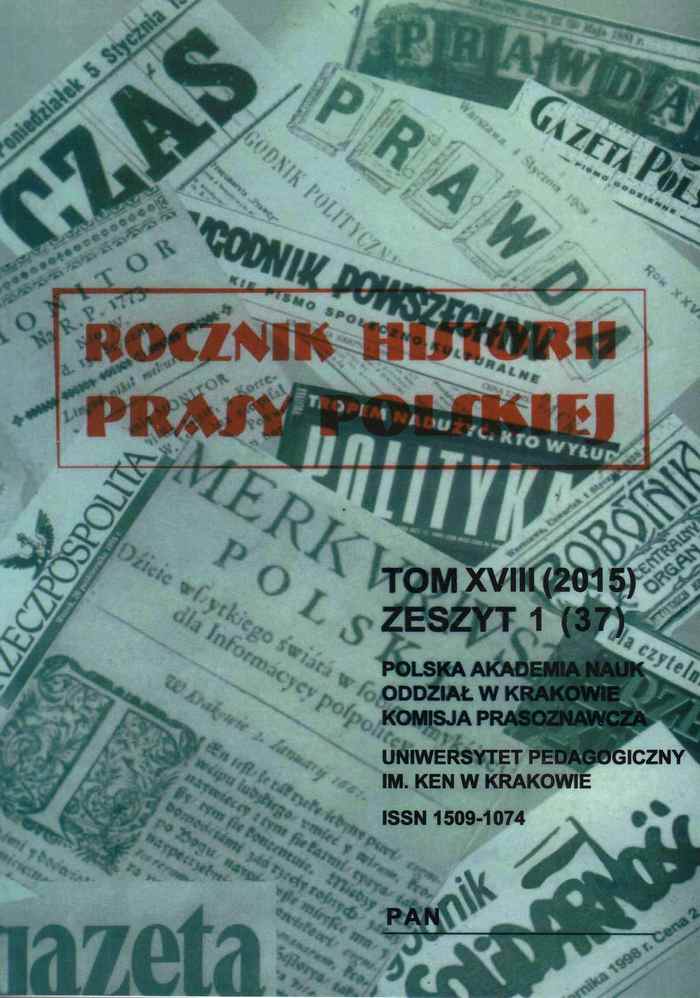The Nation of Joiners. The image of Ku Klux Klan in Polish press of 1920–1940’s.
Keywords:
Ku Klux Klan, Nationalism, Racism, Multiculturalism, Nativism, Polish pressAbstract
When discussing the perception of international events in the Polish pre-war press, it should be noted that these were frequently the subject matter in times of loss of independence such as partitioning of Poland and subsequent world wars. Some of the events happening in the history of the United States were of interest to local and national press. It applied even to one of the most violent and racist of American organizations — the infamous Ku Klux Klan. The purpose of this article is to acquaint readers with the image of the most powerful Klan of 1920’s in the Polish press. It is intriguing that the subject of Klan remains relatively unknown to Polish scientific literature. As of April 2020 there have been published only four monographies about the Invisible Empire written by Polish authors. This is puzzling because, as stated above, the subject matter of the Klan already existed in the Polish press at the time of its greatest power. Moreover, Polish-language readers during the partitions of Poland could familiarize themselves with current social and ethnic issues in the United States. One example would be a series of articles in Galician press on the William Cody’s Wild West Show which toured Polish lands in 1906. The story of William Cody’s Wild West visit to partitioned Poland was subject of recent academic research by Bartosz Hlebowicz. Details to be found in: Hlebowicz, Bartosz. "'They Stepped on Their Toes'. Reception of the Buffalo Bill's Wild West and Congress of Rough Riders of the World in Polish Press of Galicia, 1906." Acta Ethnographica Hungarica: An International Journal of Ethnography, vol. 64, no. 1, 2019, p. 153+. Gale Academic OneFile, Accessed 27 Apr. 2020.
References
Ainsworth S.H., Harward B.M., Political Groups, Parties, and Organizations That Shaped America: an Encyclopedia and Document Collection, Santa Barbara 2019.
Alexander Ch.C., The Ku Klux Klan in the Southwest: Charles C. Alexander, Lexington 1965.
Beard Ch.A., Beard M.R., A Basic History of the United States, Philadelphia 1944.
Birth of a Nation, Library of Congress, National Film Registry https://www.loc.gov/programs/national-film-preservation-board/film-registry/complete-national-film-registry-listing/ [accessed: 22.11.2019].
Blight D., Race and Reunion. The Civil War in American Memory, Cambridge 2001.
Borowiec P., Jesteśmy głosem milionów: dzieje krakowskiego Wydawnictwa i Koncernu Prasowego Ilustrowany Kurier Codzienny (1910–1939), Kraków 2005.
Cook R.A., Thomas Dixon, New York 1974.
Cook R.A., The Man Behind the Birth of a Nation, “The North Carolina Historical Review” 1962, Vol. 39, No. 4.
Crowther B., Birth of a Nation, Fifty Years After, “NY Times in Magazine” February 7. 1965.
Curry J.L., Poland's Journalists: Professionalism and Politics, Cambridge 1990.
Davenport G. Jr, Thomas Dixon's Mythology of Southern History, “The Journal of Southern History” 1970, Vol. 36, No. 3.
D’Souza D. et al., Wybaczyć Ameryce, czyli co Stany Zjednoczone dały światu, Warszawa 2015.
Gallagher G., Nolan A., “The Anatomy of the Myth.” in The Myth of the Lost Cause and Civil War History, Bloomington 2000, www.jstor.org/stable/j.ctt16gzbp2 [accessed: 22.11.2019].
Goldfield D., A Sense of Place: Jews, Blacks, and White Gentiles in the American South, “Southern Cultures” 1997, vol. 3, no. 1.
Gołębiowski M., Leksykon kultury amerykańskiej, Warszawa 1996.
Gunnar M., An American Dilemma. The Negro Problem and Modern Democracy, London 1944.
Jackson K.T., The Ku Klux Klan in the City, 1915–1930, Chicago 1994.
Katz W.L., The Invisible Empire: the Ku Klux Klan Impact on History, Seattle 1987.
Kolasa W.M., Jarowiecki J., The major Polish newspapers published until the beginning of the First World War in context of heritage preservation (characteristics, research, resources). In Newspapers: resources, processing, preservation, digitization, promotion/information, Poznań, 19–21 X 2006. in: http://eprints.rclis.org/16342/
“Ku Klux Klan.” Southern Poverty Law Center, www.splcenter.org/fighting-hate/extremist-files/ideology/ku-klux-klan [accessed: 20.05.2020].
Lerner M., America as a Civilization, New York 1957.
Mierzeński S., Amerykanie, Warszawa 1966.
Nolan A.T., The Anatomy of the Myth, [in:] The Myth of the Lost Cause and Civil War History, ed. by G.W. Gallagher, A.T. Nolan, Bloomington 2000.
Schlesinger A.M., Biography of a Nation of Joiners, “The American Historical Review” 1944, vol. 50, no. 1, pp. 1–25. JSTOR, www.jstor.org/stable/1843565 [accessed: 29.04.2020].
Shawn L., War. Revolution and the Ku Klux Klan. A Study of Intolerance in a Border State, El Paso 1985.
Sims P., The Klan, Lexington 1997.
Sobieraj J., Ku Klux Klan, Warszawa 2004.
Sowell T.. Markets and Minorities, New York 1981.
Szyszkowski W., Walka o prawa obywatelskie ludności murzyńskiej w Stanach Zjednoczonych, „Studia Iuridica” vol. VI, Toruń 1966.
Wade W.C., Fiery Cross, New York 1988.
Williamson J., A Rage for Order: Black/ White Relations in the American South Since Emancipation, New York 1986.
Wood N.D., Becoming Metropolitan: Urban Selfhood and the Making of Modern Cracow, DeKalb 2010.
Zmora H., State and Nobility in Early Modern Germany: the Knightly Feud in Franconia, 1440–1567, Cambridge 2002.
Downloads
Published
How to Cite
Issue
Section
License
Copyright (c) 2021 Rocznik Historii Prasy Polskiej

This work is licensed under a Creative Commons Attribution 4.0 International License.

